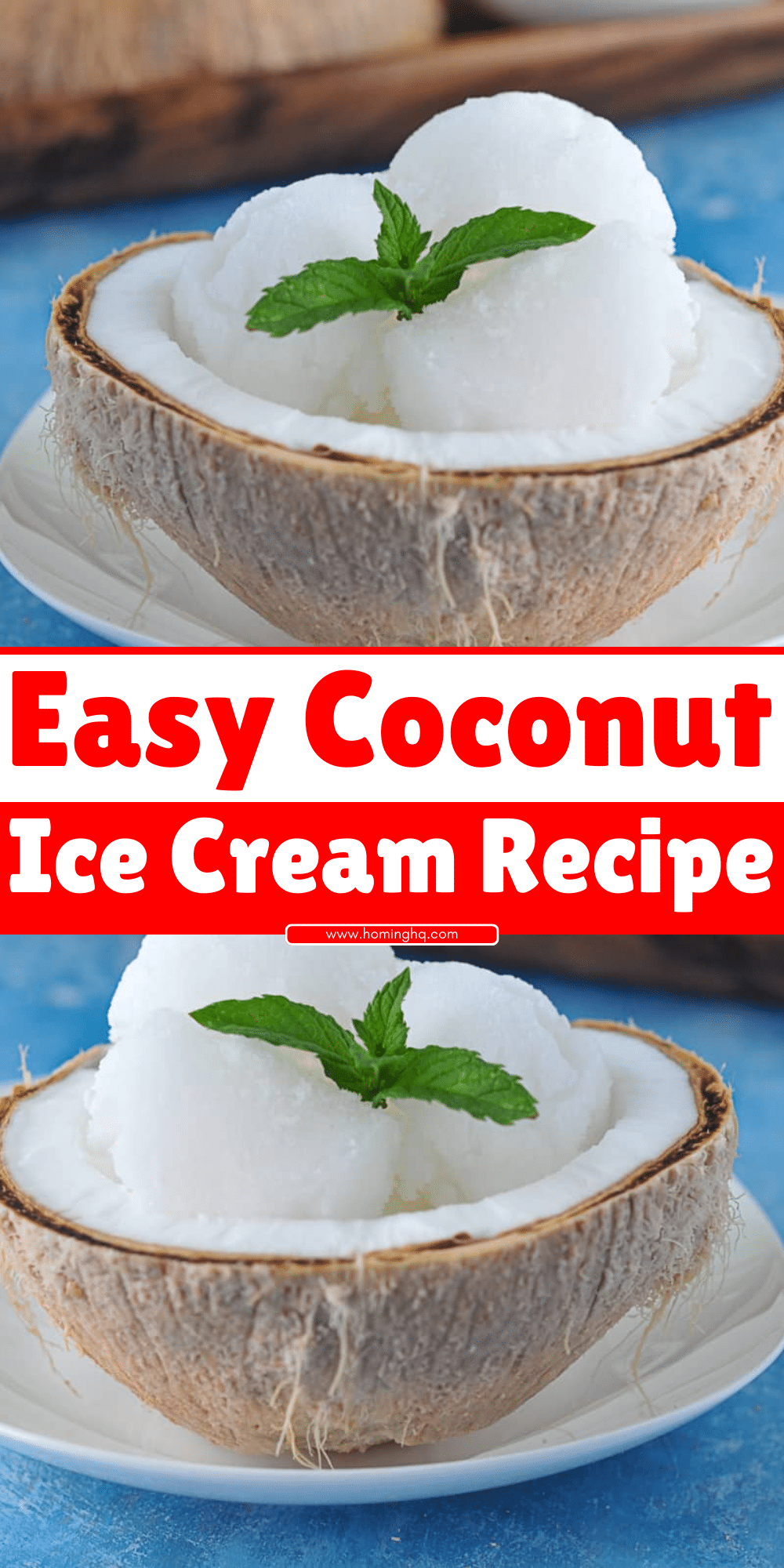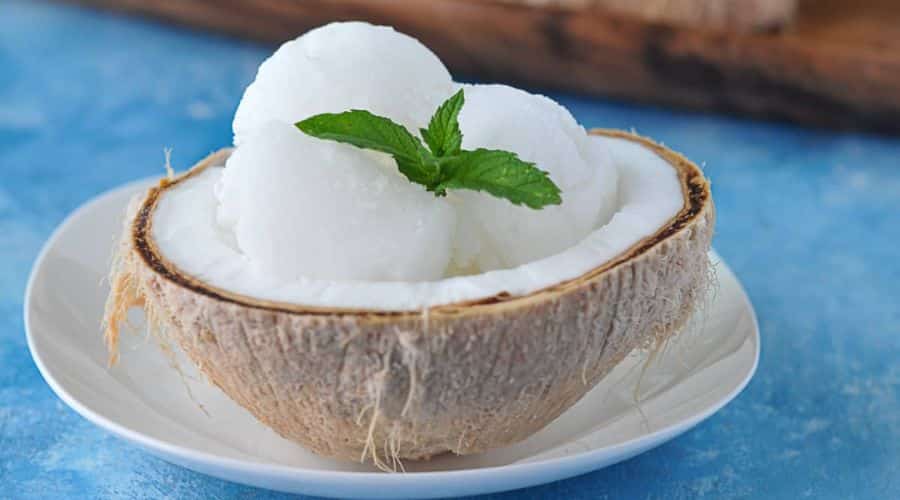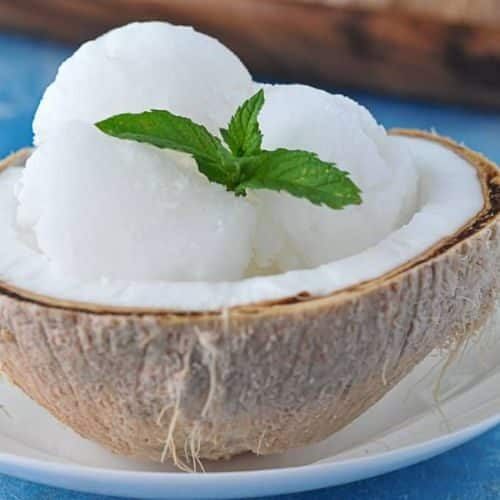All products are selected by our editorial team for quality. If you buy through our links, we may earn a small commission at no extra cost to you.
Coconut ice cream is a delightful treat that combines the rich and creamy texture of traditional ice cream with the refreshing, tropical flavor of coconut.
Whether you’re a coconut lover or simply craving something new, this dessert offers a unique experience that stands out among other ice cream varieties.
The creamy consistency comes from the natural fats found in coconut milk and cream, making it an indulgent yet dairy-free alternative to classic ice cream.
It’s a perfect dessert for warm weather, bringing a taste of the tropics to your palate.

Ingredients for Coconut Ice Cream
Essential Ingredients
To create the perfect coconut ice cream, you need to start with the right base. The key ingredients are:
- Coconut Milk: Full-fat coconut milk is the cornerstone of this recipe, providing the rich, creamy texture that makes coconut ice cream so indulgent.
- Coconut Cream: A thicker version of coconut milk, this enhances the richness and adds an even creamier texture to your ice cream.
- Sugar: Sweeten the base with regular granulated sugar or try an alternative sweetener to adjust to your taste.
- Vanilla Extract: This simple addition adds a warm, complementary flavor to the coconut.
- Salt: A small pinch of salt enhances the overall flavor by balancing the sweetness and bringing out the coconut’s natural flavor.
Optional Add-ins
While the basic coconut ice cream recipe is delicious on its own, you can take it up a notch with a variety of mix-ins:
- Toasted Coconut Flakes: For added texture and a deeper coconut flavor.
- Chocolate Chips or Chunks: A perfect combination of creamy coconut and rich chocolate.
- Fruit Chunks: Mango, pineapple, or berries bring a refreshing burst of flavor.
How to Make Coconut Ice Cream at Home

Step-by-Step Instructions
Making coconut ice cream at home is easy and straightforward. Follow these steps to create a creamy, tropical delight:
- Prepare the Base: In a medium saucepan, combine coconut milk, coconut cream, sugar, and a pinch of salt. Heat gently over medium heat, stirring constantly until the sugar dissolves completely. Do not allow the mixture to boil.
- Add Flavor: Once the sugar is dissolved, remove the mixture from heat. Stir in the vanilla extract to infuse the base with flavor.
- Chill the Mixture: Let the coconut ice cream base cool to room temperature, then place it in the refrigerator to chill for at least 2-3 hours. This step ensures a smoother texture once frozen.
- Churn the Ice Cream: Pour the chilled mixture into an ice cream maker and churn according to the manufacturer’s instructions. The mixture will gradually thicken as it freezes.
- Freeze: After churning, transfer the ice cream into a container and smooth the surface. Cover and freeze for at least 4 hours, or until the ice cream is firm and scoopable.
Tips for Perfect Consistency
To ensure your coconut ice cream has a creamy, smooth texture:
- Use Full-Fat Coconut Milk: Avoid low-fat versions, as they result in a less creamy ice cream.
- Chill the Mixture: Make sure the mixture is well-chilled before churning for the best texture.
- Stir During Freezing: If you don’t have an ice cream maker, stir the mixture every 30 minutes while it freezes to prevent ice crystals from forming.
Common Mistakes to Avoid When Making Coconut Ice Cream
Mistake 1: Using Regular Coconut Milk
When making coconut ice cream, it’s important to use full-fat coconut milk and coconut cream.
Regular coconut milk often lacks the richness and creaminess needed to create the ideal ice cream texture.
Using low-fat coconut milk will result in a much icier, less smooth consistency, which detracts from the indulgent experience.
Mistake 2: Incorrect Freezing Technique
Another common mistake is not freezing the ice cream properly.
If you don’t allow the ice cream mixture to chill enough before churning, or if the churning time is too short, the ice cream will turn out less creamy and more icy.
If you’re not using an ice cream maker, it’s crucial to stir the mixture periodically while it freezes to prevent large ice crystals from forming.
Mistake 3: Overmixing or Undermixing the Base
Overmixing or undermixing the coconut base can result in a less-than-perfect texture.
Be sure to stir the ingredients just enough to dissolve the sugar, but don’t overdo it.
Likewise, avoid under-mixing, as this can leave the mixture uneven and cause it to freeze in inconsistent textures.
Variations of Coconut Ice Cream
Vegan Coconut Ice Cream
For those who follow a plant-based diet, making vegan coconut ice cream is a breeze!
Coconut ice cream is naturally dairy-free, so simply ensure that all your ingredients align with vegan standards.
Use coconut milk and coconut cream as your base, and opt for plant-based sweeteners like maple syrup or agave to replace sugar.
The flavor remains just as creamy and indulgent, making it a perfect treat for vegans and non-vegans alike.
You can even add your favorite vegan mix-ins such as dark chocolate chunks or coconut yogurt for extra creaminess.
Chocolate Coconut Ice Cream
For chocolate lovers, turning coconut ice cream into a decadent chocolate variation is a simple twist.
To make chocolate coconut ice cream, melt some dark or milk chocolate (depending on your preference) and whisk it into the coconut base while it’s still warm.
The chocolate will blend smoothly into the coconut cream, creating a rich and velvety dessert.
You can also swirl in chocolate fudge or add chocolate chips for an extra crunch.
This variation gives a perfect balance between the tropical coconut flavor and rich chocolate.
Mango Coconut Ice Cream
If you love tropical flavors, a mango coconut ice cream is a must-try.
Puree fresh or frozen mangoes and blend it into the coconut base before churning.
The combination of sweet mango and creamy coconut is a refreshing treat that evokes the taste of tropical vacations.
You can even add a few chunks of mango throughout for added texture and a burst of fresh flavor with each bite.
Coconut Lime Ice Cream
Add a zesty twist to your coconut ice cream by incorporating lime.
Simply mix fresh lime juice and lime zest into your coconut base before churning.
The tangy, citrusy notes of lime pair beautifully with the coconut, giving you a bright and refreshing dessert.
This variation is especially perfect for summer or when you’re craving a bit of extra zing.
How to Serve Coconut Ice Cream
Topping Ideas
While coconut ice cream is delicious on its own, adding a few toppings can elevate it to a whole new level of indulgence. Here are some topping ideas to inspire your creativity:
- Toasted Coconut Flakes: A sprinkle of toasted coconut enhances the flavor and adds a crunchy texture that complements the smoothness of the ice cream.
- Fresh Fruit: Tropical fruits like mango, pineapple, or berries provide a burst of freshness and natural sweetness that balances the richness of the coconut.
- Chocolate Syrup or Fudge: Drizzle chocolate syrup, hot fudge, or even caramel sauce for a sweet contrast to the coconut’s creaminess.
- Chopped Nuts: Toasted almonds, pistachios, or cashews add a salty crunch that pairs perfectly with the creamy ice cream.
- Whipped Cream: For a more indulgent treat, top your coconut ice cream with a dollop of whipped cream, adding a light and airy contrast.
Best Pairings
Coconut ice cream pairs beautifully with many desserts and drinks, making it an incredibly versatile treat. Here are a few pairing suggestions:
- Coconut Cake: Serve a scoop of coconut ice cream alongside a slice of coconut cake for the ultimate coconut lover’s dessert experience.
- Tropical Fruit Salad: A bowl of fresh tropical fruit, such as papaya, kiwi, and dragon fruit, pairs perfectly with coconut ice cream, enhancing the exotic vibe.
- Iced Tea or Coconut Water: For a refreshing beverage, pair your coconut ice cream with a chilled glass of iced tea or coconut water to complement the tropical flavors.
- Pineapple Upside-Down Cake: The rich, caramelized flavor of pineapple upside-down cake works wonderfully with the creamy coconut ice cream, making for an indulgent dessert duo.
Health Benefits of Coconut Ice Cream
Why It’s a Great Dairy-Free Option
Coconut ice cream is an excellent choice for individuals who are lactose intolerant or follow a vegan lifestyle.
Since it’s made from coconut milk and coconut cream, it’s naturally dairy-free, making it a safe and delicious option for those avoiding dairy products.
Coconut milk also contains medium-chain triglycerides (MCTs), which are healthy fats that can provide energy and may help with weight management.
Nutritional Information
Coconut ice cream provides a variety of nutrients.
It’s rich in healthy fats from coconut, particularly MCTs, which are known to support brain function and may aid in improving cholesterol levels.
Coconut also provides essential vitamins and minerals, including magnesium, potassium, and iron.
However, as with most ice cream, it’s important to enjoy coconut ice cream in moderation, as it can be calorie-dense due to its fat content.
Coconut ice cream can be a healthier alternative to traditional dairy ice cream, especially when made with natural sweeteners and minimal additives.
If you make it at home, you can control the ingredients, using options that suit your dietary needs and preferences.
Rich in Antioxidants
Coconut contains antioxidants that help protect your body from free radical damage.
These antioxidants, along with the beneficial fats in coconut, help support the immune system and promote overall wellness.
Opting for homemade coconut ice cream allows you to avoid the preservatives and artificial additives often found in store-bought versions.
Conclusion
Coconut ice cream is a truly versatile and indulgent dessert.
With its creamy texture and tropical flavor, it’s perfect for those seeking a dairy-free treat or anyone who loves the rich taste of coconut.
Whether you prefer it plain or with exciting variations like chocolate, mango, or lime, coconut ice cream offers endless possibilities for customization.
Paired with fresh fruits, nuts, or a drizzle of syrup, it can become a show-stopping dessert for any occasion.
Additionally, coconut ice cream can offer health benefits like being a good source of MCTs and antioxidants.
With the ability to adjust the sweetness and add-ins, it’s a treat that can suit various dietary preferences and needs.
So, why not try making your own coconut ice cream at home?
It’s easier than you think and will surely impress your guests or satisfy your sweet cravings!
Frequently Asked Questions About Coconut Ice Cream
1. Can I Make Coconut Ice Cream Without an Ice Cream Maker?
Yes, you can make coconut ice cream without an ice cream maker!
Simply follow the basic recipe but instead of churning the mixture, pour it into a shallow dish and place it in the freezer.
Every 30 minutes, stir the mixture with a fork to break up any ice crystals and ensure a smooth texture.
After about 4-6 hours, your ice cream should be firm and ready to serve.
2. Can I Use Frozen Coconut Milk?
Frozen coconut milk can be used in making coconut ice cream, but it’s essential to allow it to thaw completely before using it in your recipe.
Frozen coconut milk may separate, so give it a good stir or blend it once it’s thawed to ensure a smooth consistency.
Using frozen coconut milk may slightly alter the texture, so be sure to check for creaminess during the process.
3. Is Coconut Ice Cream Healthier than Regular Ice Cream?
Coconut ice cream can be considered a healthier option compared to traditional dairy ice cream, especially if you use natural sweeteners and minimal additives.
It’s lower in lactose and contains beneficial fats (MCTs) from coconut.
However, it’s still a calorie-dense treat, so it’s best enjoyed in moderation.
4. Can I Make Coconut Ice Cream Without Sugar?
Yes, you can make coconut ice cream without sugar.
There are many sugar alternatives available, such as stevia, agave syrup, or maple syrup, which can be used in place of regular sugar.
Just keep in mind that some sugar substitutes may affect the texture or sweetness of the final product, so you may need to adjust the quantities accordingly.
5. How Long Does Homemade Coconut Ice Cream Last?
Homemade coconut ice cream can last for up to 2-3 weeks in the freezer.
To keep it fresh, make sure it’s stored in an airtight container.
If the ice cream becomes too hard or icy over time, let it sit at room temperature for a few minutes before serving to allow it to soften and become scoopable again.

Coconut Ice Cream
Equipment
- Ice Cream Maker (if available)
- Medium Saucepan (for heating the mixture)
- Whisk (for stirring)
- Measuring Cups and Spoons
- Mixing Bowl
- Freezer-Safe Container (for freezing the ice cream)
Ingredients
- 1 can 13.5 oz – Full-Fat Coconut Milk
- 1 can 13.5 oz – Coconut Cream
- ¾ cup – Granulated Sugar or to taste
- 1 tsp – Vanilla Extract
- Pinch – Salt
(Optional Add-ins):
- ½ cup – Toasted Coconut Flakes or more for topping
- ¼ cup – Chocolate Chips or other mix-ins
Instructions
- Prepare the Coconut Base: In a medium saucepan, combine the coconut milk, coconut cream, sugar, and a pinch of salt. Heat over medium heat, stirring constantly until the sugar dissolves completely. Do not allow the mixture to boil.
- Add Vanilla: Once the sugar has dissolved, remove the saucepan from heat and stir in the vanilla extract.
- Chill the Mixture: Allow the coconut mixture to cool to room temperature. Once cooled, cover and refrigerate for 2-3 hours or until fully chilled.
- Churn the Ice Cream: If using an ice cream maker, pour the chilled coconut mixture into the ice cream maker and churn according to the manufacturer’s instructions. This process usually takes about 20-30 minutes.
- Freeze: Transfer the churned ice cream to a freezer-safe container and smooth the top. Freeze for 4-6 hours, or until the ice cream is firm.
- Serve: Once frozen, scoop the coconut ice cream into bowls or cones and garnish with toasted coconut flakes, chocolate chips, or fresh fruit, if desired.
Notes
- Customizing the Flavor: You can easily customize this recipe by adding different mix-ins like chocolate chips, crushed cookies, or fresh fruit like mango or berries.
- No Ice Cream Maker?: If you don’t have an ice cream maker, pour the mixture into a shallow dish, place it in the freezer, and stir every 30 minutes to break up any ice crystals until it reaches the desired consistency (about 4-6 hours).
- Storage: Store leftover coconut ice cream in an airtight container in the freezer for up to 2-3 weeks. Let it sit at room temperature for a few minutes before scooping if it becomes too hard.

